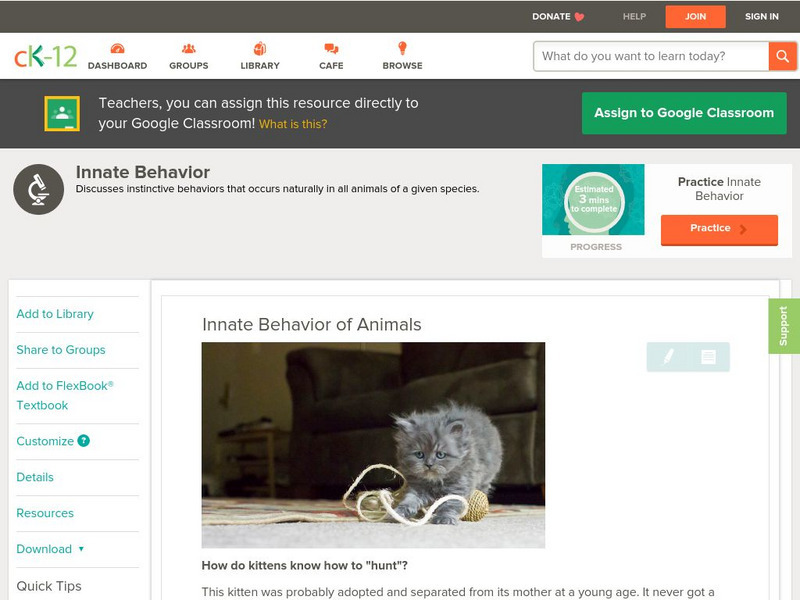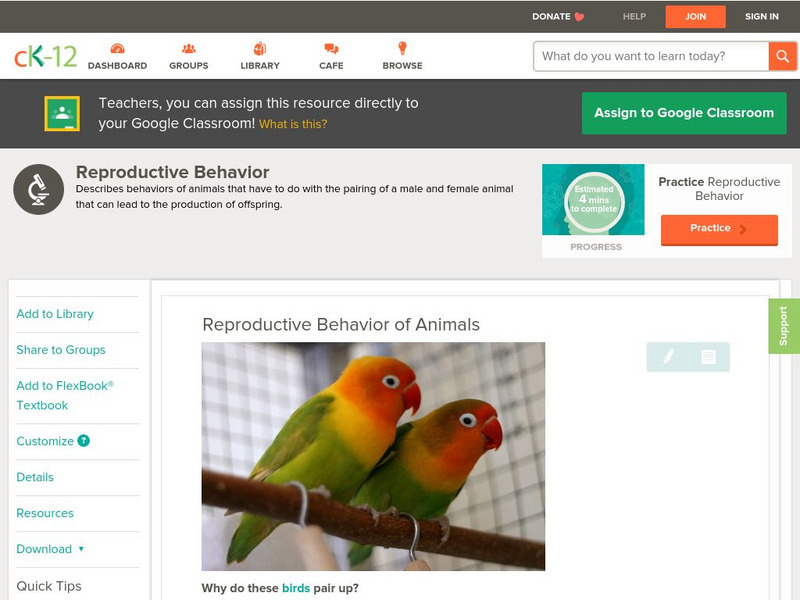CK-12 Foundation
Ck 12: Life Science: Innate Behavior of Animals
[Free Registration/Login may be required to access all resource tools.] Many animal behaviors are ways that animals act naturally. They are not learned behaviors. Cats are natural-born hunters. They don't need to learn how to hunt....
CK-12 Foundation
Ck 12: Life Science: Animal Behaviors
[Free Registration/Login may be required to access all resource tools.] Barking, purring, and playing are just some of the ways in which dogs and cats behave. These are examples of animal behaviors. Animal behavior is any way that...
PBS
Pbs Learning Media: How Animals Care for Their Young
In this interactive lesson, students learn that animals take care of their young in many of the same ways the adults in their lives take care of them.
PBS
Pbs Learning Media: How Animals Care for Their Young
In this interactive lesson, students learn that animals take care of their young in many of the same ways the adults in their lives take care of them. Students watch videos from NATURE and engage in a variety of activities to check...
Unite for Literacy
Unite for Literacy: Animals: Small and Mighty Mammals
Learn about some of the special skills some small mammals have. Includes audio narration in Turkish and English, with text in English.
CK-12 Foundation
Ck 12: Biology: Animals: Behavior Study Guide
This comprehensive study guide covers the necessary vocabulary and concepts for a unit on animal behavior.
NC State University
Nc State University: General Entomology, Elements of Behavior
Behavior is what animals do. It can be defined more precisely as an internally directed system of adaptive activities that facilitate survival and reproduction. Ethology is the scientific study of animal behavior -- particularly when...
PBS
Pbs Learning Media: Wild Kratts: All About Lizards Lesson Plan
Students explore the diversity of lizards in terms of characteristics, behavior, and habitat. Activities feature five species of lizards and their special body structures needed for survival.
ArtsNow
Arts Now Learning: Magic Rocks [Pdf]
In this lesson, students work in groups with each acting as a predator, prey, or family member in a particular habitat. They present their habitat performance to the class and students identify the habitat and animal relationships. Then,...
National Geographic Kids
National Geographic Kids: Animals: Coyotes
Learn all about coyotes on this great multi-media site. Video and audio clips, fun facts and great pictures make this a good National Geographic site for research projects.
CK-12 Foundation
Ck 12: Life Science: Social Behavior of Animals
[Free Registration/Login may be required to access all resource tools.] Why is animal communication important? Without it, animals would not be able to live together in groups. Animals that live in groups with other members of their...
CK-12 Foundation
Ck 12: Life Science: Cyclic Behavior of Animals
[Free Registration/Login may be required to access all resource tools.] Many animal behaviors change in a regular way. They go through cycles. Some cycles of behavior repeat each year. Other cycles of behavior repeat every day. Learn...
E-learning for Kids
E Learning for Kids: Science: Christmas Island: What Do Animals Eat?
This lesson teaches students the three different types of diets animals may have - herbivore, carnivore, and omnivore.
Alabama Learning Exchange
Alex: Nocturnal Animals Lesson #1
This lesson can be part of a two-week integrated thematic unit on nocturnal animals. During this lesson, students will be introduced to nocturnal animals. They will have an opportunity to navigate web sites to learn more about nocturnal...
Enchanted Learning
Enchanted Learning: Polar Bears
Learn more about the polar bear when you visit this informative site that features a diagram of the polar bear and information on its diet, habitat, anatomy, reproduction and so on.
E-learning for Kids
E Learning for Kids: Science: Center of the Atlantic Ocean: Animals and Their Senses
Captain Ed Smith and his dog, Rocco, are exploring all the amazing senses animals have. Join him and discover with them.
PBS
Pbs Learning Media: Animal Shelter Photographer
In this WILD TV segment, a photographer helps find homes for animals up for adoption.
Alabama Learning Exchange
Alex: Importance of Fur for Animals
This is a lesson to teach students how to read a thermometer and gain an understanding of why fur is important for some animals' survival.
PBS
Pbs Learning Media: Animal Fitness Lesson Plan
In this lesson using commonly known animals such as a fox, dog and an inchworm, learners enjoy learning about the movements of various animals. The teacher demonstrates how to move and be like that animal using various exercises and...
PBS
Pbs Learning Media: Wild Kratts: Graphic Organizers (English)
Channel your inner 'Creature Power' while watching Wild Kratts! Dig deep into the video clips using these learning resources.
PBS
Pbs Learning Media: Gila Monster
This video segment from Outdoor Nevada looks at the Gila monster's behavior, habitat, and unique adaptive characteristics. [3:55]
CK-12 Foundation
Ck 12: Life Science: Reproductive Behavior of Animals
[Free Registration/Login may be required to access all resource tools.] Some of the most important animal behaviors involve mating. Mating is the pairing of an adult male and female to produce young. Adults that are most successful at...
A-Z Animals
A Z Animals: Animal Facts: Camel (Camelus Dromedarius)
View images and learn facts about Camels, including their evolution, appearance, habitat, behavior, breeding, diet, and conservation status.
A-Z Animals
A Z Animals: Animal Facts: Chinstrap Penguin (Pygoscelis Antarcticus)
Learn facts about Chinstrap Penguins, including where they live, their appearance, behavior, diet, and breeding.
















